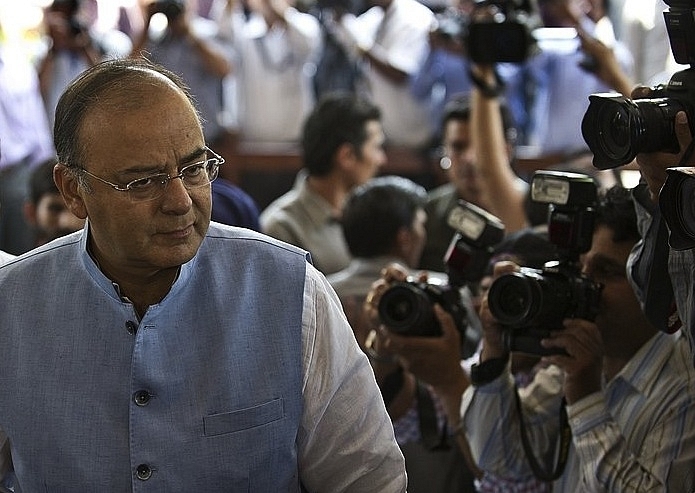Economy
At Least Four Out Of The 13 PSU Banks Getting Recap Bounties Didn’t Deserve It
- The NDA government’s decision to offer almost the entire budgetary outlay for bank recapitalisation upfront is a good move
- But, through its plain-vanilla recap ideas, it has missed a golden opportunity to reformat the relationship between public sector banks and taxpayer funds towards something more sustainable

Arun Jaitley (PRAKASH SINGH/AFP/Getty Images)
The NDA government’s decision to offer almost the entire budgetary outlay for bank recapitalisation upfront is a good move. Of the Rs 25,000 crore earmarked for this purpose, Rs 22,915 crore is being pumped into 13 public sector banks, with the State Bank of India swallowing nearly a third of it at Rs 7,575 crore. Three-quarters of the cash is being given immediately, with the balance to be linked to performance.
Recapitalising banks at the start of the year makes sense as this will allow them to clean up their balance-sheets faster and resume lending, hopefully by the third or fourth quarter of the year. Without a spike in lending, it is difficult to see investment reviving.
But two points need to be made: one, the money still isn’t enough; and two, it is not being optimally targeted.
Arun Jaitley will have to find resources to double his recapitalisation funds, given the seriousness of the bad loans problem. At last count, public sector banks had gross non-performing assets (GNPAs) of Rs 4,76,816 crore, which accounts for the 9.32 percent of their gross loan portfolio. Put simply, Rs one out of every Rs ten lent may be unrecoverable.
This level of gross NPAs needs much higher recapitalisation than the Rs 25,000 crore allocated for this year. Jaitley will need to double his recap funds, even if it overshoots his fiscal deficit limits. Recap funds are unlikely to immediately impact inflation.
The second point is more important. Of the 13 banks (see table below) that got capital on a platter, at least a handful didn’t deserve it. The first principle in banking is not to throw more good money after bad, and the government’s decision to pump additional capital in banks that may not survive as standalone entities makes little sense.
Consider Indian Overseas Bank (IOB), which had gross NPAs of 17.4 percent of its total advances and net NPAs (after provisions) of 11.89 percent as of March 2016. It has been given Rs 3,101 crore– all of which will be soaked up in writing off bad loans.
Or, consider Central Bank of India (gross NPAs of 12 percent), which got a large dollop of recap funds (Rs1,729 crore). Or UCO Bank (gross NPAs of 15.43 percent and recap funds of Rs 1,033 crore). Or Dena Bank (gross NPAs of ten percent, and recap funds of Rs 594 crore).
It is more than likely that these banks would have been shut
down or acquired if they were not owned by the government. But the logic of
investing is the same whether you are a private sector bank or a public one:
the ones least likely to find their feet should be candidates for euthanasia or
merge with a stronger bank.
Three other alternatives could also have been considered.
First, make them narrow banks, whose only job would have been to recover bad loans and raising deposits. These deposits can be invested in government bonds or relent in the inter-bank market. High NPA banks should have been barred from lending beyond a limit to anyone without 100 percent liquid collateral, etc. They can be reinstated as normal banks when the recovery process is clearly underway.
Second, create a bad bank or two. Indian Overseas Bank, with gross NPAs of 17.4 percent, is already one-sixth a bad bank; i.e., a sixth of its loans have already gone bad. Why could it not have been converted into a full-fledged “bad bank” by selling off its good loans and buying the bad loans of other banks at a deep discount? Pumping over Rs 3,100 crore in IOB would have made sense if it had been converted into a bad bank whose only purpose was loan recovery.
Third, privatising management on a contractual basis. In this arrangement, the CEO and top management would be paid normal public sector salaries but a bonus through stock options. Earmarking two to five percent of the equity for stock options that can be encashed when these banks achieve specified performance parameters and are fully profitable would bring a double benefit: higher share values, and the ability to generate future capital through ploughed back profits. The big losers should have been thrown into the water and forced to swim or sink, but with private sector managers as lifeguards. It is worth recalling that Bank of Baroda, which reported the largest losses for any public sector bank ever in the third and fourth quarters of 2015-16, has declined government infusions of capital. Its private sector bosses think they can revive the bank by taking tough decisions and getting the staff to perform better. This is the way to go even for weaker banks.
Through its plain-vanilla recap ideas, the NDA has missed a golden opportunity to reformat the relationship between public sector banks and taxpayer funds towards something more sustainable.
Introducing ElectionsHQ + 50 Ground Reports Project
The 2024 elections might seem easy to guess, but there are some important questions that shouldn't be missed.
Do freebies still sway voters? Do people prioritise infrastructure when voting? How will Punjab vote?
The answers to these questions provide great insights into where we, as a country, are headed in the years to come.
Swarajya is starting a project with an aim to do 50 solid ground stories and a smart commentary service on WhatsApp, a one-of-a-kind. We'd love your support during this election season.
Click below to contribute.
Latest